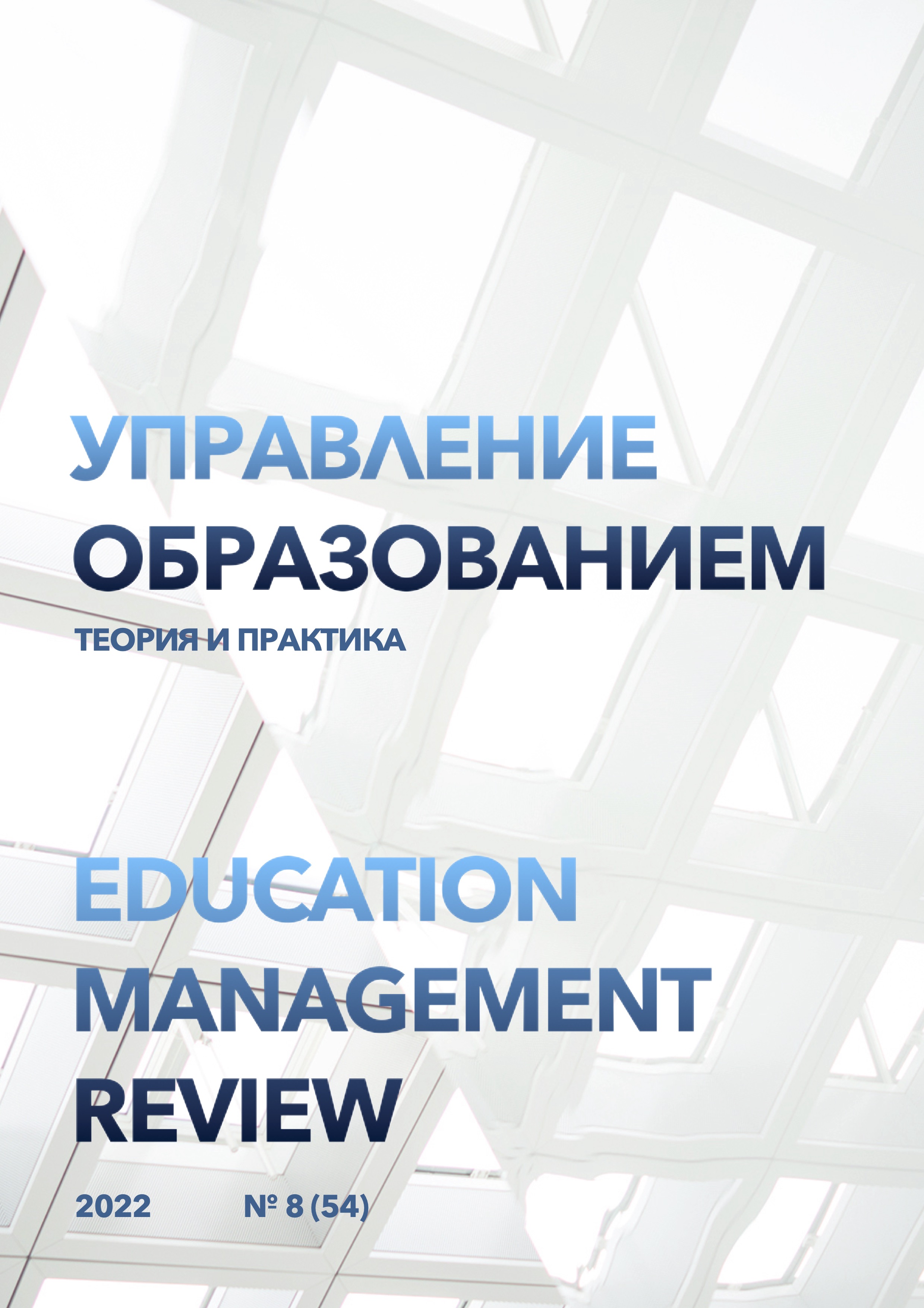Implementation of the integrated learning model in primary school with the activation of cognitive activity
DOI:
https://doi.org/10.25726/f6822-1849-3309-qKeywords:
training, integration, integrated learning, formation, activation of cognitive activityAbstract
The model of training the teaching staff to work at the school assumes the presence of not only the already approved tools for assessing the quality of education, but also the formation of learning principles. For this purpose, the structure of integrated education is used, which forms the possibility of a holistic knowledge of the surrounding world for schoolchildren and the use of technologies for sustainable education on the teacher's side. The novelty of the research is determined by the fact that integrated learning can be involved not only within the boundaries of teaching future teachers, but above all the possibility of applying the principles of integrated learning for schoolchildren. The authors show that integrated learning can be implemented only when preparing the younger students themselves and revealing their own thinking and desire for knowledge. The article defines the possibility of using a methodological complex that a future teacher can apply to work with schoolchildren and value attitudes that subsequently form the desire of schoolchildren to learn. The practical significance of the study is determined by the fact that the use of the integrated learning methodology makes it possible to expand pedagogical techniques in high school.
References
Буренкова Н.В., Данилова Т.В., Тонких А.П. Инновационный подход к формированию модели современного учителя российской школы // Управление образованием: теория и практика. 2020. № 4(40). С. 29-36.
Демидова Т.Е., Чижевская И.Н., Чижевский А.Е. Формы организации учебных занятий в подготовке студентов к формированию универсальных учебных действий у младших школьников / В сборнике: Стратегия и тактика подготовки современного педагога в условиях диалогового пространства образования. Сборник научных статей. 2017. С. 203-209.
Тонких А.П. Проектная деятельность и формирование общекультурных и профессиональных компетенций будущего учителя начальных классов // Начальная школа плюс До и После. 2013. № 8. С. 33-37.
An, J., & Su, Z. (2011). Searching a “work-integrated learning” teaching practice for the mould professional course. Lecture Notes in Electrical Engineering, 111 LNEE, 187–192. https://doi.org/10.1007/978-3-642-24823-8_30
Ariffin, H. F., Raja-Abdullah, R. P. S., Baba, N., & Hashim, S. (2015). Structural relationships between career development learning, work integrated learning and employability: A structural equation modelling approach. In Theory and Practice in Hospitality and Tourism Research - Proceedings of the 2nd International Hospitality and Tourism Conference 2014 (pp. 89–93). https://doi.org/10.1201/b17390-18
Chaithanu, K., Nuangpirom, P., & Ruangsiri, K. (2020). A development of instructional model based on work-integrated learning for new generation of graduates: Case study of Fujikura electronics (Thailand) Ltd. Advances in Intelligent Systems and Computing, 1134 AISC, 456–468. https://doi.org/10.1007/978-3-030-40274-7_45
Cheng, Y., & Zhang, R. (2010). A framework of project-based integrated learning environment for animation design. In Proceedings - 2010 International Conference on Artificial Intelligence and Education, ICAIE 2010 (pp. 433–436). https://doi.org/10.1109/ICAIE.2010.5641463
Du, C., Liu, H., & Wei, L. (2010). On the characteristics and application of integrated e-learning. In 2010 2nd International Conference on E-Business and Information System Security, EBISS2010 (pp. 659–661). https://doi.org/10.1109/EBISS.2010.5473280
Fahrurrozi, Hasanah, U., & Dewi, R. S. (2019). Integrated Learning Design Based on Google Classroom to Improve Student Digital Literacy. In 2019 5th International Conference on Education and Technology, ICET 2019 (pp. 108–111). https://doi.org/10.1109/ICET48172.2019.8987219
Jia, L., Cao, L., & Chiu, M. (2013). Analysis on data-based integrated learning control for batch processes. Communications in Computer and Information Science, 355, 130–138. https://doi.org/10.1007/978-3-642-37105-9_15
Masethe, M. A., & Masethe, H. D. (2013). A mentorship model for simulated work integrated learning using windows phone. In Lecture Notes in Engineering and Computer Science (Vol. 1, pp. 212–215).
Merzlykin, O., & Topolova, I. (2018). Developing of key competencies by means of augmented reality in science and language integrated learning. In CEUR Workshop Proceedings (Vol. 2105, pp. 465–468).
Nkhata, B. A., & Breen, C. (2010). A framework for exploring integrated learning systems for the governance and management of public protected areas. Environmental Management, 45(2), 403–413. https://doi.org/10.1007/s00267-009-9410-9
Pop, C., & Möwes, D. (2014). Facilitating collaboration between industry and educational institutions to promote work integrated learning ePortfolio development. In ACM International Conference Proceeding Series (Vol. 2, pp. 223–224). https://doi.org/10.1145/2662155.2662212
Poppins, P., & Singh, M. (2005). Work integrated learning in information technology education. IFIP Advances in Information and Communication Technology, 182, 223–230. https://doi.org/10.1007/0-387-25997-x_25
Rutkauskiene, D., Mark, R., Kubiliunas, R., & Gudoniene, D. (2013). Functional architecture of a service-oriented integrated learning environment. In Proceedings of the European Conference on e-Learning, ECEL (pp. 431–439).
Schedin, S., & Hassan, O. A. B. (2016). Work integrated learning model in relation to CDIO standards. Journal of Applied Research in Higher Education, 8(3), 278–286. https://doi.org/10.1108/JARHE-11-2014-0104
Thumtathong, A., Premthaisong, S., & Srisawasdi, N. (2019). Teaching english with science: A result of content and language integrated learning approach and mobile-assisted inquiry pedagogy. In ICCE 2019 - 27th International Conference on Computers in Education, Proceedings (Vol. 2, pp. 286–293).
Tochtermann, K., & Granitzer, G. (2008). The long way towards workplace-integrated learning. In Proceedings - The 8th IEEE International Conference on Advanced Learning Technologies, ICALT 2008 (pp. 8–13). https://doi.org/10.1109/ICALT.2008.170
Usmeldi, U., & Amini, R. (2019). The effect of integrated learning model to the students competency on the natural science. In Journal of Physics: Conference Series (Vol. 1157). https://doi.org/10.1088/1742-6596/1157/2/022022
Usmeldi, & Amini, R. (2020). The effect of integrated science learning based on local wisdom to increase the students competency. In Journal of Physics: Conference Series (Vol. 1470). https://doi.org/10.1088/1742-6596/1470/1/012028
Väljataga, T., & Mettis, K. (2019). Analyzing Integrated Learning Scenarios for Outdoor Settings. Lecture Notes in Computer Science (Including Subseries Lecture Notes in Artificial Intelligence and Lecture Notes in Bioinformatics), 11841 LNCS, 287–294. https://doi.org/10.1007/978-3-030-35758-0_27
Vyas, R., Jacob, M., Faith, M., Isaac, B., Rabi, S., Sathishkumar, S., … Ganesh, A. (2008). An effective integrated learning programme in the first year of the medical course. National Medical Journal of India, 21(1), 21–26.




